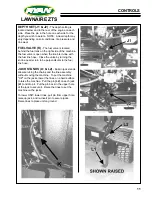
17
LAWNAIRE ZTS
OPERATION
AERATING
NOTE: For best performance, the lawn to be aerated
should be thoroughly watered the day before.
1. Drive machine to the site to be aerated.
2. Set the tine depth stops to the desired aeration
depth.
3. Lower the tines by rocking the raise-lower switch
forward.
4. Drive the machine forward to aerate. When aerat-
ing, drive with the front tire next to the line of cores
from the previous pass to avoid overlap and get
even aeration.
5. Raise the tines when crossing hard surfaces, such
as driveways or sidewalks or going over things like
sprinkler heads
6. To obtain maximum benefit, a second pass may be
made at right hand angles to the first or by lapping
by 1/2.
Aerating TIPS
– Typical aeration core depth is 2 1/2" to 3" (60-
75mm). This gets below the surface compaction
and is easily performed. The machine is capable
of going deeper in the right soil conditions, but
noticeably more power is required. This increases
wear and tear on the entire drive train with minimal
additional benefit from the increased depth.
– The machine may be turned with the tines in the
ground within limits. Too tight a turn will lead to the
tines tearing turf. A good rule of thumb is to limit
turns to about a 4' (1.2m) inside radius.
– When aerating a lawn, operate across the lawn.
Raise the tines at the end of the pass, turn around,
then lower the tines to continue on the next pass.
To finish, aerate the perimeter.
Use of the Depth Stops (J1 & J2)
– The depth stops enable consistent core depth in
varying soil conditions by setting the maximum core
depth. A consistent core depth keeps the machine
from bogging down when going from harder to
softer soil for more consistent operation and better
performance.
– Both depth stops need to be set to the same depth
to avoid twisting the aeration frame. The depth
stops set the maximum depth the tines penetrate
to. Actual depth may vary due to soil conditions,
tires, tire pressure and tine condition and wear.
– To get a consistent core depth, watch the depth
stops and depth arms. The depth arms should stay
tight against the depth stops pins when the tines
are in the ground. Occasional movement up is
acceptable and helps protect the tine assembly if it
rides over a rock or other buried object. Adjust the
down pressure with the pressure control to keep
the depth arms tight against this pins in normal
operation. Actual pressure is indicated by the pres-
sure gauge on the control panel,. In normal aerat-
ing conditions, 200-400 psi should give 2 1/2" to 3"
core depths.
Excess pressure:
– Wastes fuel. Pressure is generated by the hydrau-
lic lift pump. More pressure takes more power
– Creates excess heat. More pressure generates
more heat which must be removed via the oil
cooler
and reservoir.
– Creates greater loads on the components in the lift
system.
















































